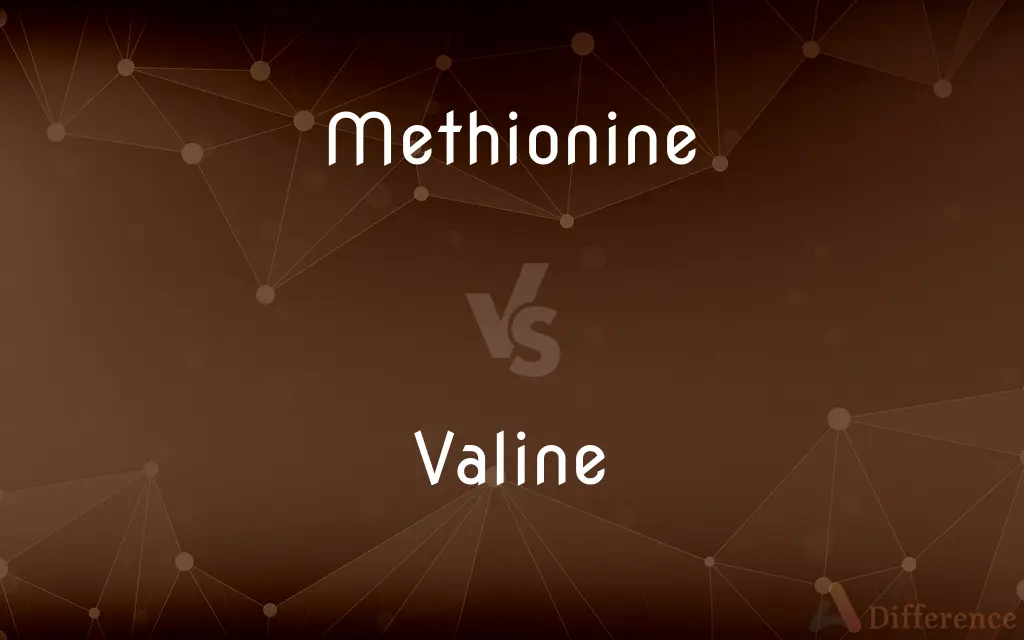Methionine vs. Valine — What's the Difference?
Edited by Tayyaba Rehman — By Fiza Rafique — Updated on March 31, 2024
Methionine is an essential amino acid important for growth and tissue repair, featuring a sulfur-containing side chain, while valine is a branched-chain essential amino acid crucial for muscle metabolism and energy production.

Difference Between Methionine and Valine
Table of Contents
ADVERTISEMENT
Key Differences
Methionine plays a critical role in the body's metabolism and detoxification. It acts as a precursor to cysteine and taurine, amino acids necessary for antioxidant defenses and healthy nervous system function. Methionine is unique due to its sulfur-containing side chain, which contributes to its ability to donate methyl groups for biochemical reactions. Whereas, valine is part of the branched-chain amino acids (BCAAs) group, which is especially important for muscle protein synthesis and energy production during physical activity. Valine's structure helps in the stimulation of muscle growth and regeneration.
Methionine is essential for the synthesis of proteins and some critical biomolecules, including S-adenosylmethionine (SAMe), a compound involved in methyl group transfers and thus influencing gene expression and cell function. On the other hand, valine plays a significant role in regulating nitrogen balance in the body and providing energy to muscle cells, helping to preserve muscle mass and support recovery after physical stress.
The body cannot synthesize methionine, making it essential to obtain through diet, with high levels found in eggs, nuts, seeds, and meat. Valine, also not synthesized by the body, must be ingested through food, with rich sources including dairy, grains, mushrooms, soy products, and meat. Both are vital for health but serve different physiological functions.
Methionine's sulfur content contributes to its antioxidant properties, helping to neutralize free radicals and support liver health. In contrast, valine's role in muscle metabolism makes it particularly important for athletes and those undergoing intense physical training, as it can enhance energy production and aid in muscle repair.
Understanding the distinct functions and dietary sources of methionine and valine is crucial for maintaining a balanced diet and supporting various bodily functions, from detoxification and tissue repair to muscle metabolism and energy provision.
ADVERTISEMENT
Comparison Chart
Classification
Essential amino acid with a sulfur-containing side chain
Branched-chain essential amino acid
Main Function
Metabolism, detoxification, tissue repair
Muscle metabolism, energy production
Unique Property
Contains sulfur, important for methyl group transfers and antioxidant defense
Part of the BCAAs, crucial for muscle protein synthesis
Dietary Sources
Eggs, nuts, seeds, meat
Dairy, grains, mushrooms, soy products, meat
Role in Health
Supports liver health, antioxidant properties, influences gene expression
Preserves muscle mass, supports recovery after exercise
Compare with Definitions
Methionine
An essential amino acid that contains sulfur.
Methionine is crucial for the synthesis of other amino acids and proteins.
Valine
A branched-chain essential amino acid used for energy in muscles.
Valine is metabolized directly in the muscle, providing energy.
Methionine
Important for detoxification and metabolism.
The liver utilizes methionine in various detoxification processes.
Valine
Helps regulate nitrogen balance in the body.
Valine contributes to the maintenance of proper nitrogen levels for muscle metabolism.
Methionine
Necessary for tissue repair and growth.
Adequate methionine levels are essential for the repair of damaged tissues.
Valine
Can be found in dairy products and meats.
Including dairy in one's diet is a good way to obtain valine.
Methionine
Acts as a precursor for critical molecules like SAMe.
Methionine's conversion into SAMe is vital for methyl group donations.
Valine
Plays a key role in muscle protein synthesis.
The presence of valine is crucial for the regeneration of muscle tissue.
Methionine
Found in high quantities in protein-rich foods.
To ensure adequate methionine intake, one should include eggs and meat in their diet.
Valine
Supports physical recovery and preserves muscle mass.
Athletes consume valine supplements to aid in recovery after intense workouts.
Methionine
Methionine (symbol Met or M) () is an essential amino acid in humans. As the precursor of other amino acids such as cysteine and taurine, versatile compounds such as SAM-e, and the important antioxidant glutathione, methionine plays a critical role in the metabolism and health of many species, including humans.
Valine
Valine (symbol Val or V) is an α-amino acid that is used in the biosynthesis of proteins. It contains an α-amino group (which is in the protonated −NH3+ form under biological conditions), an α-carboxylic acid group (which is in the deprotonated −COO− form under biological conditions), and a side chain isopropyl group, making it a non-polar aliphatic amino acid.
Methionine
A sulfur-containing essential amino acid, C5H11NO2S, obtained from various proteins or prepared synthetically and used as a dietary supplement and in pharmaceuticals.
Valine
An essential amino acid, C5H11NO2.
Methionine
A lipotropic, sulphur-containing essential amino acid, C5H11NO2S, found in most protein.
Valine
An essential amino acid 2-amino-3-methylbutanoic acid found in most animal proteins.
Methionine
A crystalline amino acid containing sulfur; found in most proteins and essential for nutrition
Common Curiosities
What foods are high in methionine?
Foods high in methionine include eggs, nuts, seeds, and meats.
Why is valine important?
Valine is important for muscle metabolism, energy production, and aiding in muscle tissue repair and growth.
Can the body produce methionine and valine?
No, both methionine and valine are essential amino acids that must be obtained through the diet.
Is methionine good for the liver?
Yes, methionine supports liver health through its roles in detoxification and antioxidant defense.
What is methionine used for in the body?
Methionine is used for protein synthesis, metabolism, detoxification, and as a precursor to other important biomolecules.
Can vegetarians and vegans get enough methionine and valine?
Yes, with careful planning, plant-based sources can provide adequate amounts of these essential amino acids.
What is the difference between methionine and valine in terms of structure?
Methionine contains a sulfur-containing side chain, while valine is characterized by a branched-chain structure.
Are methionine and valine supplements necessary?
Supplements might be necessary for certain individuals with specific health conditions or dietary restrictions but aren't typically required with a balanced diet.
How does valine support physical activity?
Valine supports physical activity by providing energy to muscles, helping to preserve muscle mass, and aiding in recovery.
What role does valine play in muscle growth?
Valine is crucial for muscle protein synthesis, making it important for muscle growth and regeneration.
Do methionine and valine have any side effects?
In excessive amounts, they could lead to health issues, but they're generally safe when consumed through food or as part of a balanced diet.
Can methionine and valine deficiency affect health?
Yes, deficiencies can lead to issues like muscle loss, weakened immune system, and impaired growth and tissue repair.
How can I ensure I get enough methionine and valine in my diet?
Including a variety of protein-rich foods like dairy, meat, eggs, nuts, and grains in your diet can help ensure adequate intake.
How do methionine and valine affect athletic performance?
Methionine can aid in recovery and detoxification, whereas valine is directly involved in energy production and muscle synthesis, enhancing athletic performance.
How do methionine and valine work together in the body?
While they serve different functions, both are essential for protein synthesis and overall health, contributing to a balanced amino acid profile necessary for bodily functions.
Share Your Discovery

Previous Comparison
Judgment vs. Conviction
Next Comparison
Odysseus vs. UlyssesAuthor Spotlight
Written by
Fiza RafiqueFiza Rafique is a skilled content writer at AskDifference.com, where she meticulously refines and enhances written pieces. Drawing from her vast editorial expertise, Fiza ensures clarity, accuracy, and precision in every article. Passionate about language, she continually seeks to elevate the quality of content for readers worldwide.
Edited by
Tayyaba RehmanTayyaba Rehman is a distinguished writer, currently serving as a primary contributor to askdifference.com. As a researcher in semantics and etymology, Tayyaba's passion for the complexity of languages and their distinctions has found a perfect home on the platform. Tayyaba delves into the intricacies of language, distinguishing between commonly confused words and phrases, thereby providing clarity for readers worldwide.
















































